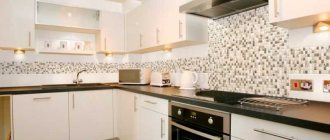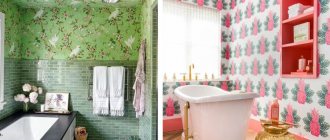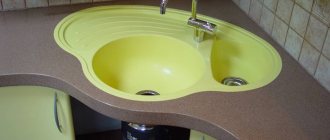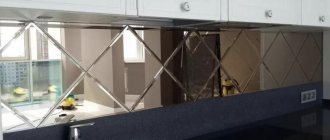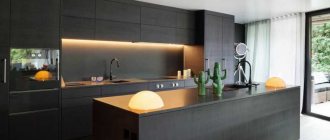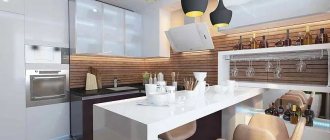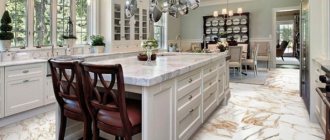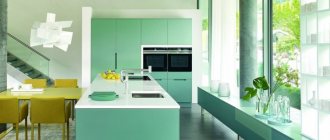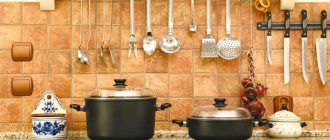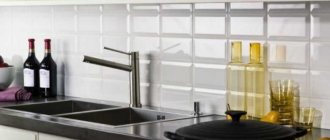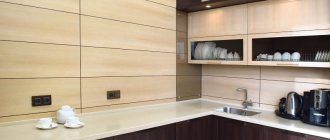Any kitchen planner and designer will tell you that a tile backsplash can instantly transform a space. Regardless of the shade of color, texture, water resistance - a decent kitchen apron is the best choice! Find out what types of ceramic tiles for kitchen backsplashes come in, how to match them to your kitchen design, popular sizes, types and decors of kitchen tiles.
A well-made kitchen backsplash is a brilliant accent piece and one of the best-selling kitchen decor items with interesting textures, colors and patterns. Determining the best tile for a kitchen backsplash is a matter of preference and a willingness to experiment. However, there are some things to know when looking for your dream tile.
Ceramic kitchen apron
This type of cladding, pictured above, can be found in every second kitchen in our country. The installation of plain and medium-color tiles using standard techniques deserves attention. This apron looks simple and reliable, and is also the most budget-friendly and versatile option.
Ceramic tiles are a traditional and still popular solution. Only a few years ago tiles in the 10x10 cm format prevailed, but nowadays large formats of ceramic tiles, polished porcelain tiles laid with thin joints, structural tiles or hexagons are gaining popularity in modern kitchens.
In any case, such a kitchen apron is very practical, easy to clean and durable. The availability of formats, structures, colors of ceramics and porcelain tiles means that they can be used to furnish a kitchen in any style.
Large format tiles placed above the worktop mean that the kitchen wall becomes a smooth, virtually seamless surface that blends perfectly with the worktop or floor. Large format tiles are produced in countless colors, which is their added advantage.
Mosaic tiles for kitchen
Mosaic is a cladding consisting of small elements that can be successfully used on the walls and floor of the kitchen. It can be made of ceramics, glass, natural stone and even metal or wood. It is also possible to combine different materials. This combination gives unlimited decorative possibilities. The biggest advantage, besides its charm, is the ability to easily adapt to the most bizarre curves and uneven surfaces.
Small elements that have geometric shapes of regular or varied shapes create beautiful compositions, thanks to which the wall in the kitchen receives not only the usual protection from moisture or dirt, but also becomes a central element.
What is important to know about tiling kitchen work surfaces?
The surfaces near the stove, cutting countertop and sink get dirty the most. This is a wall space within 50-60 cm where fat settles during frying, drops when washing dishes and food juices when cutting meat, vegetables and fruits. With frequent cooking, the surface of the kitchen apron becomes dirtier than the floors in 2-3 days. But cooking must take place in a clean environment, so hygiene comes first in the kitchen.
The original design of a kitchen backsplash made of ceramic tiles and other materials consisting of small fragments is associated with the complexity of installation and cutting. Very rarely, the gap from the countertop to the wall cabinets coincides with the format of the facing materials in several rows or a continuous sheet. Sometimes it’s easier to rehang the wall unit of a kitchen unit by changing the size of the apron than to deal with the labor-intensive cutting of tiles.
Apron with a pattern in the kitchen interior
Beautiful kitchen design with an apron
Kitchen design with apron
Attention! A standard tile cutter is sufficient for cutting tiles or ceramic trim. But he will not take porcelain stoneware and some types of natural stone prepared for cladding. Some construction supermarkets offer services for cutting hard materials with a waterjet machine.
See alsoKitchen renovation, interior design and decoration
Boar tile for kitchen backsplash
When you are going to buy ceramic hog tiles, remember that you need to add about 10% to the amount you calculated in case some tiles break as a result of unsuccessful cutting and other possible defects. Thus, you will be insured against forced downtime in the middle of the work process.
The most popular styles for boar tiles are Scandinavian style, Provence, industrial style and country. The “boar” at the base of the apron allows you to create the most unexpected compositions. This is achieved using tiles that vary in color, texture and size. If you have chosen an older kitchen style, it is best to buy tiles that are coated with a glaze, which causes small cracks to form on the surface of the tiles. A “hog” with a matte surface is best suited for some design areas.
Green tiles are suitable for country style, you can say about blue shades that look bright and attract all the attention to each other. But most housewives prefer chic and cheerful red aprons.
How much does it cost to install a kitchen backsplash?
How much it will cost to install a tile kitchen backsplash depends on the square footage used, and keep in mind that kitchens come in all shapes and sizes with awkward angles, making professional installation costs subjective. In general, marble, ceramic and porcelain offer versatility with unique designs. Experiment with grout to change the mood of your kitchen when working with this material.
In 2021, we expect to see the trend continue as more and more homeowners end up with wall cabinets. A full height kitchen splashback can give tile a fresh and modern look by highlighting a single area of the kitchen, creating a focal point.
Taller tile backsplashes will tie all aspects of the space together, especially if you use white materials. Not to mention, tile can create a visual break from the rest of the kitchen unit, making the kitchen feel more open by adding surface area. Feel free to play with a combination of colors, textures and patterns to create an even more luxurious look.
A tile kitchen backsplash is a good opportunity to introduce sophisticated style and make a bright accent. If you want to convey luxury, choose black or charcoal gray tiles. Try a color you'd never even consider and watch the magic happen right before your eyes. If you're feeling unsure, you can always introduce a new color in one or two lines or in individual tiles scattered throughout the backsplash.
Glass tiles
Also very popular material. As for modern styles, such material is used for High-Tech, Modern, and Minimalism.
The main advantages of glass slabs:
- It has a beautiful appearance, which you can’t argue with, because it really looks just great, especially if the kitchen is decorated in light colors.
- Excellent technical parameters, according to which this material is much better than ceramic, as well as stronger and more durable, and is not afraid of high levels of humidity. Its surface is not too porous, which means it is much easier to clean. In addition, it does not absorb moisture.
- Since the color is applied from the back, the material does not fade.
- Installation and installation of this material is completely simple. To do this, you do not need to buy anything additional, except for ordinary sealant and grout.
- Due to its versatility, the material is harmonious with other finishing options.
Check out the ways to design a tile backsplash in your kitchen to see the chic look of the glass material.
Which grout to choose for tiles
For an expert, there is nothing difficult about laying kitchen tiles, but for a beginner who needs to cope with outside corners, it will not be so easy. Particular attention should be paid to seams, a contrasting joint should be chosen, and the layout and sealing should be of simply excellent quality. To play it safe, it is better to choose a more standard solution, which can be:
- white;
- grey;
- beige.
The solution must be of high quality, not afraid of moisture, frequent washing and temperature changes. If you are on a budget and choose a cheaper option, be prepared that the grout will darken very quickly and will not have an aesthetic appearance. The best solution in this case is epoxy resin powder. This moisture-resistant substance that repels dirt does not darken even over time, the only drawback is that all actions must be performed very quickly, otherwise the composition will simply dry out. For the same reason, tiles should be chosen in small areas for laying, otherwise there may not be time to clean the surface and the joints will harden.
The solution is removed with a special composition, which can then be used as a detergent for ceramic surfaces.
Advantages and disadvantages of tiles for finishing kitchens
Today, kitchen walls and backsplashes are increasingly decorated with tiles. This material has already proven its practicality, which is incredibly important in kitchen areas.
With proper installation and selection of this particular material, you will be convinced of its durability and practicality for many years, which will save you from the need to frequently make repairs in the kitchen. It is resistant to high humidity and temperature changes, and retains its original attractive appearance for a long time when compared with other finishing materials.
Before making repairs, you must understand all the advantages and disadvantages of this material. After all, changing it if desired will be more difficult than wallpaper, or repainting the walls.
In any home, the kitchen occupies a special place. After all, families gather here, spend time with guests, and also organize festive events. Accordingly, it is regularly exposed to detergents, high humidity and temperature changes. During the preparation of meals, all surfaces in this room succumb to grease and various dirty drops. It follows from this that the materials must be easy to wash and clean. But tile is such a material!
White tiles for a backsplash in the kitchen
Don’t be afraid to buy white tiles for a backsplash, because caring for them will not be more difficult than tiles of any other color, because this finishing material is one of the most practical.
Thus, a kitchen apron made of white brick can also please the eye with its snow-white beauty; in addition to the white background, dirt in the form of dust, dirt, grease stains and wet streaks will not be visible as clearly as on dark tiles. Another benefit of brick-look tiles is that they add to the aesthetics of the kitchen. If white tiles become the backsplash of a mini-kitchen, its space will visually look larger than it actually is.
Apron design
This zone is located above the cooking area. It is she who takes the brunt of the cooking process.
The cooking area includes: a stove and a table for cutting food, a sink.
It is tiles that are recommended to be used for a kitchen apron, because this particular material is practical and simply ideal!
Literally up to 20 cm, the dimensions of the apron should extend beyond the cooking area. Take this nuance into account!
The porosity of the material should be the smallest, since in this zone the wall absorbs the maximum “load”. Accordingly, stone and ceramic tiles are far from the best options. Here you should prefer glass or porcelain stoneware.
As for color design, there are two options:
- The apron is decorated in the same tone as the entire kitchen, complementing the overall palette, complementing the kitchen space.
- The splashback contrasts with the main frame, creating an accent and making the kitchen feel fresh and modern.
It is worth remembering the mosaic design method. By the way, this method is very interesting and gives room for imagination in order to design an apron.
Dimensions of tiles and backsplash
The height of the apron in the kitchen work area is usually 50-60 centimeters. When choosing the size of the tile, make sure that its height and width are multiples of the height and width of the apron. Then pruning will not be necessary or will be minimal. It is advisable that the apron extends a couple of centimeters under the upper and lower cabinets. It is important to take into account the protrusion under the hood.
- Very popular size: 10*10 cm. Perfect for a small kitchen. It will look harmonious with a small set. Does not require trimming during installation. It is convenient to cover the apron in hard-to-reach places and combine it with other tiles or panels.
- Other sizes are also available for sale. For example, 20x20, 20x30, 30x30, 30x40, 30x60 cm. Laying them is easier and faster, but trimming is often required. Small kitchens are not tiled with large tiles. They visually spoil the interior; the kitchen seems smaller.
- Ceramic bricks or “hog”. This is a tile with beveled edges. Comes in different sizes and colors. Looks great in both modern and traditional kitchens.
- Mosaic is coming back into fashion. Beautiful, but demanding to maintain; skill in working with such complex cladding is required.
- Ceramic blocks with the illusion of a mosaic pattern. The effect is achieved using a convex pattern or deep tile joints, which are filled with grout. Capricious to care for.
- Shapes with embossed edges are used in bold design projects when you want to focus on the apron.
What types of styling are there?
- Traditional or simple.
- In a run-up or with a shift.
- Diagonal (you can add a diamond or deck layout here).
- Herringbone.
- Combination (with a different color or size).
- Modular grid (made of slabs of different sizes).
- Chess.
- Complex pattern (for example: kaleidoscope).
The photo below illustrates all the options listed above.
Methods of laying tile trim and decor
Regardless of the area of the kitchen apron, ceramic tiles or tiles can be laid in different ways.
- Standard - rectangles or squares are joined seam to seam, covering the cement or adhesive base as much as possible with grout. The simplest method, which even beginners can easily handle, but it is important to make the same seams. You need a minimum consumption of tiles, and there is an opportunity to save on the remainder of the batch, which is often offered at a discount. Knowing the area of the apron, it is easy to select the cladding of the required size and calculate the number of tiles individually.
- Diagonally is a popular method of laying tiles. It visually expands the space of a small kitchen, especially if the entire room is covered in this way, and not just the apron. But you have to make a purchase with a reserve - when cutting, there is a high probability of the formation of uneven edges, chips and other defects. Usually this is entrusted to specialists with tools, and you can finish the “diamond” wall yourself. Often this layout is combined with other varieties in the design of a tiled kitchen apron.
- “In a run-up” or with a seam offset, a common type of tiling. Reminiscent of brickwork, if they are small rectangles. Tile materials imitating brick and formatted stone are laid only this way. It always looks good, sometimes offset rows are used for diagonal and vertical laying. The disadvantage is that it takes a lot of time to cut.
- Seamless installation requires perfectly cut tile materials. In fact, there are seams, but they are almost invisible, especially with a matte texture. It does not involve grouting, but for hygiene purposes the apron is replaced with transparent sealant or construction silicone. Used under Italian tiles and porcelain tiles without chamfer or precisely cut facing marble.
- Herringbone is another type of cladding with rectangular fragments. An old method, borrowed from the diagonal laying of parquet at right angles, as in the photo.
- “Chess” is the most famous way of combining tiles of contrasting colors. It is borrowed from the black and white marble floor finishing practiced in Gothic castles and temples. This installation is also suitable for tiles of the same type with a simple pattern, when the turns form an intricate pattern.
- The linear butt method is used for laying edges, frames for decorative inserts, baseboards and other oblong decor. For example, a kitchen apron made of tiles - a design with a ready-made panel.
- Kaleidoscopic cladding involves multi-colored decor, where you can combine straight masonry and mosaic fragments.
Note! The same tile will be perceived differently in the design of a kitchen backsplash, even if color variations are not used.
See also: What mistakes should you avoid in designing and choosing the style of a winter garden?
Brown apron in the kitchen interior
Kitchen design with apron
Beautiful apron in the kitchen interior
See also: Choosing the right tile design for the kitchen
What should you consider when choosing?
- First you need to decide on the style in which the apron and the kitchen as a whole will be made.
- Indoors, you need to consider lighting as sunlight makes colors brighter and lighter. Indoor lights make colors feel warm, while halogen lights give the feel of cool colors. If the renovation is done on your own, then it is worth familiarizing yourself with the basics of color in order to avoid color overlap (for example, blue shades under indoor yellow light give a green tint).
- Large sizes are suitable for a large kitchen, and accordingly, small ones will look harmonious in a small kitchen.
- The square shape looks familiar and if you want to add originality, it is better to use round, hexagonal, triangular or irregular geometric tiles.
- Light colors visually enlarge the kitchen and allow you to emphasize the furniture, while dark colors visually make the kitchen smaller. Bright contrasting colors draw attention to the apron, and bedding to the furniture.
- A smooth shiny surface will brighten the room, while a matte surface will make the room smaller.
- The contrasting color of the grout will attract attention, and the color of the grout will make the surface visually seamless.
- Tiles for the apron must be purchased with a reserve, adding 5-10% for a simple installation method and 15% - 20% when laying diagonally, combined or in a complex pattern. Also, a reserve is taken in case of a fight, unsuccessful pruning, defects and for the future, if the apron needs to be repaired.
- All materials for covering the apron must be purchased in one batch and in the same shade.
Aprons in kitchens of different styles
The choice of tiles is also determined by the style in which the interior is designed. Below in the article for each option there are examples of successful design, as well as ideas for new products and unusual solutions.
Modern style
Trend number one, inspired by nature itself: the effect of natural materials (white or gray veined marble, rough stones, minerals, wood, leather and other interesting textures).
Ceramic parquet is gaining popularity, which will create the presence of wood in the interior in restrained (bleached and gray) shades. Imitation of metal or concrete surfaces is no less popular.
In modern interiors, one of the trends has been the use of black and white, combining them not only in color, but also in texture. Diagonal, checkerboard and herringbone patterns are popular.
Smooth monochromatic tiles with a simple stylized pattern or photo print in the style of the 80s, as well as a 3D effect, creating the illusion of movement and volume will fit perfectly into the interior.
High tech
One of the new products is seamless ceramic tiles, which allow you to reduce or completely eliminate the seam gap. Designers appreciated modern technologies.
Often this style uses ceramics with a metallic sheen or painted to look like metal.
Plain color with geometric edges will fit perfectly into the interior. Black and gray colors emphasize the severity of the style. The cladding should only be carried out by a qualified specialist who can maintain the clarity of the lines, which is so important for this style.
Loft
This style is characterized by raw, rough, rough and matte surfaces, which are ideal for creating the necessary atmosphere. For several seasons now, the fashion for the effect of aged finishes, plaster, concrete surfaces and terracotta brickwork has held its position.
A win-win “hog” will also do.
Such an apron will require special care. Sometimes preference is given to ceramics with an imitation of red-brown or white brick.
An artificially aged surface with scuffs looks very impressive.
Classic
Characterized by simplicity of form, absence of complex lines, muted color. An apron trimmed with ceramic blocks imitating natural stone (marble, granite, travertine, etc.) or classic decors (antique ornaments or delicate panels) will look organic and natural. Traditionally monochromatic neutral shades without decorations. The most commonly used colors are white, milky or beige.
But there are colors such as sand, walnut, cognac, gray. It can be either monochromatic with a light pattern.
It will be interesting to look at artificially aged tiles, as if they have their own history. Particular attention is paid to the food preparation area, under the hood. An addition can be panels or strips with floral or relief patterns, geometric strict or three-dimensional designs, or a pattern of tiles of a different color.
The “runaway” masonry from the “hog”, reminiscent of brickwork, fits very well.
For rooms with low ceilings, the cladding can be done vertically. Another popular technique is to lay out the stripes exactly under each other (in columns), using different shades of the same color. White, beige, black or a calm, rich color will emphasize the sophistication and sophistication of a traditional interior.
Design tips for combining a white apron with other shades
- Black tones in the kitchen interior are ideally combined with a white apron. This color scheme is typical for the Art Nouveau style, but in others it is used less often. A light apron looks especially elegant in combination with white walls and black furniture.
- Combining with red will help create a contrasting and stylish room, where this piece of furniture will be very appropriate and will ideally set off the facades of the set.
- A white apron will optimally dilute the green color scheme of the interior.
- In a plain, light kitchen, you should not use such a color scheme, otherwise the room will turn into a solid white spot.
A white apron goes well with many bright and rich colors in kitchen design: lilac, orange, blue and blue, brown and yellow. The main thing is to minimize light elements in kitchens in which pastel (milky, beige) and natural tones (wood, stone, sea wave, etc.) predominate, otherwise the room will become one merging spot and will not have its own individuality and uniqueness.
